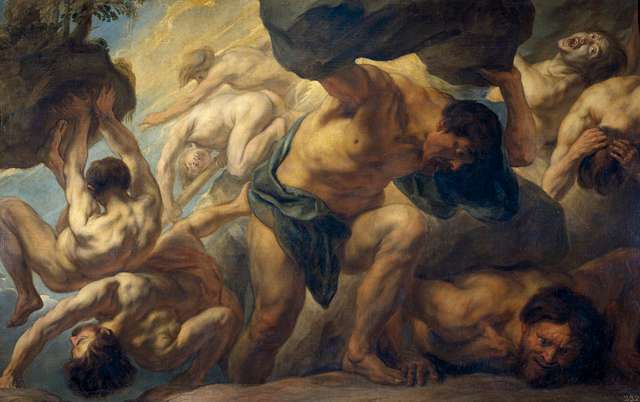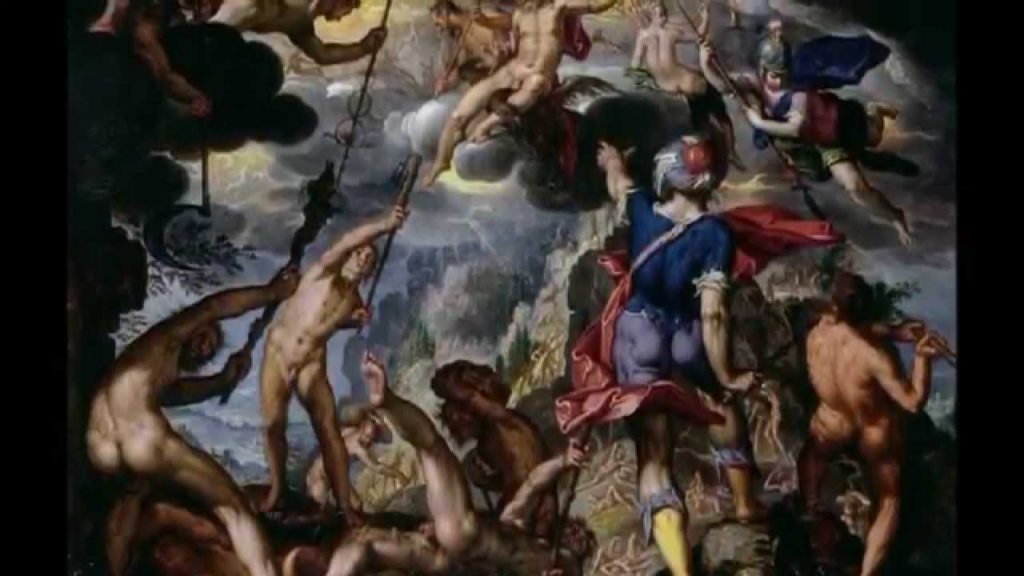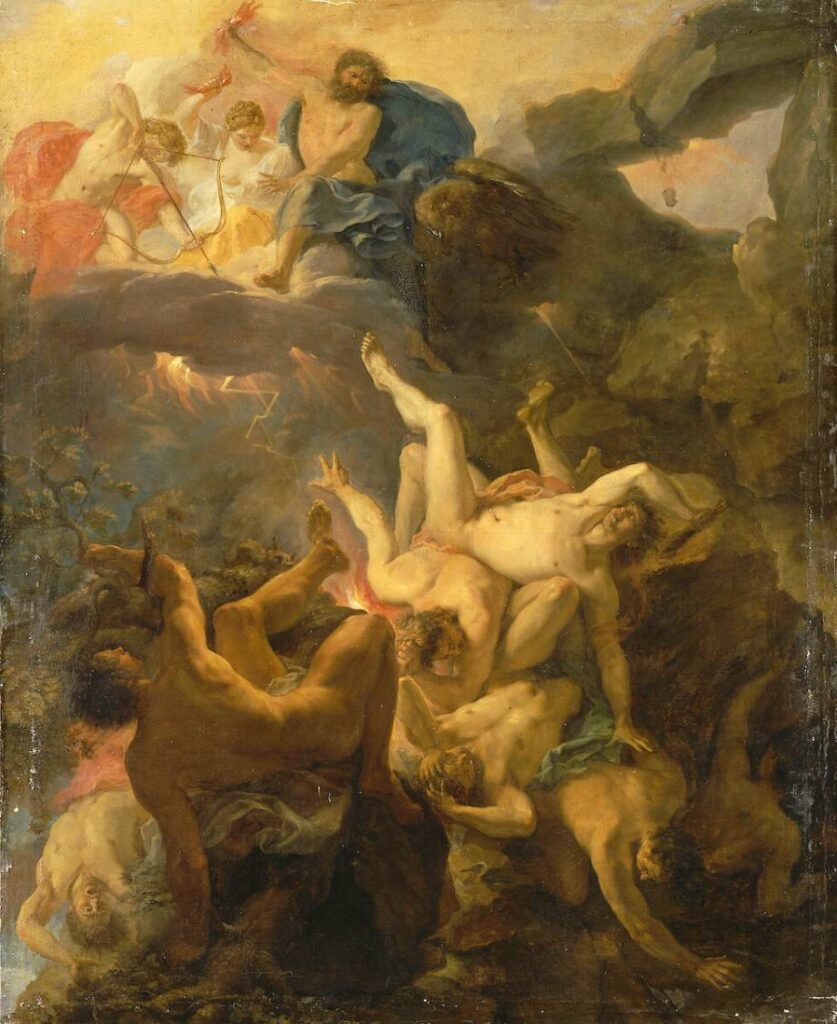“When Gods Go to War: The Epic Tale of the Titanomachy in Greek Mythology”

Introduction
In the vast and immortal tapestry of Greek mythology, few tales are as awe-inspiring and cosmic in scale as the Titanomachy—the ten-year war between the elder gods known as the Titans and the younger generation of deities led by Zeus, who would go on to form the Olympian pantheon.
This celestial conflict wasn’t merely a war for power—it was a mythic clash between old and new, order and chaos, tradition and transformation. The Titanomachy lays the mythological foundation for how the world of the gods came to be and explains the transition of divine rule from the primordial entities to the gods of Mount Olympus.

The Primordial Beginnings: Chaos and Creation
Before the Titans or Olympians ruled, there was Chaos—a yawning void. From Chaos emerged primordial deities like:
- Gaia (Earth)
- Uranus (Sky)
- Tartarus (the Abyss)
- Nyx (Night)
- Eros (Desire)
Gaia gave birth to Uranus, and together, they produced the first generation of gods: the Titans, Cyclopes, and Hecatoncheires (hundred-handed giants).
The Titans: The First Gods
The Titans were twelve in number (six male, six female), including:
- Cronus (leader)
- Rhea
- Oceanus
- Hyperion
- Iapetus
- Themis, and others
These deities were powerful elemental forces associated with time, the ocean, celestial light, and cosmic order. Cronus, the youngest Titan, eventually overthrew his father Uranus with Gaia’s help, using a sickle to castrate him—an act that symbolized the end of the primordial age.
The Rule of Cronus and the Prophecy
After Uranus’s fall, Cronus took the throne, ruling during a mythical Golden Age. However, he was warned by Gaia and Uranus that he, too, would be overthrown by his own son. To prevent this, Cronus devoured each of his children at birth.
His wife, Rhea, desperate to save at least one child, tricked Cronus when Zeus was born. She hid the infant Zeus in a cave on Crete and gave Cronus a swaddled stone instead.
The Rise of Zeus and the Olympians
Raised in secret by nymphs and protected by the Curetes (warriors who masked his cries), Zeus grew in strength and cunning. Upon reaching adulthood, he confronted Cronus.
Zeus’s First Move: The Great Vomit
Zeus forced Cronus to regurgitate his siblings—Hestia, Demeter, Hera, Hades, and Poseidon—all fully grown. These six children of Cronus formed the core Olympian gods.
But reclaiming their place was not enough. To truly seize power, they had to overthrow the Titans.
The Titanomachy: War of the Gods
What Was the Titanomachy?
The Titanomachy (“Battle of the Titans”) was a ten-year war between:
- The Titans, led by Cronus, with allies like Atlas, Menoetius, and Prometheus (initially).
- The Olympians, led by Zeus, with siblings and several powerful allies.
Key Locations:
- Mount Othrys: Stronghold of the Titans.
- Mount Olympus: Base of the Olympian gods.
- Tartarus: The deep abyss beneath the Earth, destined to be the prison of defeated Titans.
The Turning Point: Allies from the Deep
The Olympians initially struggled against the might of the Titans. But Gaia advised Zeus to release her imprisoned sons—the Cyclopes and the Hecatoncheires—whom Uranus and Cronus had locked in Tartarus out of fear.
Gifts of Power:
- The Cyclopes, grateful for their freedom, forged powerful weapons:
- Thunderbolt for Zeus
- Trident for Poseidon
- Helmet of Invisibility for Hades
- The Hecatoncheires, with their hundred arms, hurled boulders that shook the Earth and sky.
With these new allies, the tide turned.
The Final Battle and the Defeat of the Titans
The war climaxed in an apocalyptic battle, shaking the cosmos. Flames, storms, earthquakes, and tidal waves engulfed the world as Titan and Olympian clashed.
Eventually, the Olympians triumphed.
- Cronus and most of the Titans were defeated and cast into Tartarus, bound by adamantine chains and guarded by the Hecatoncheires.
- Atlas was punished separately—forced to hold up the sky for eternity.
- Some Titans, like Prometheus and Epimetheus, were spared because they supported Zeus or did not fight.
Aftermath: The Age of Olympus Begins
With the Titans defeated, Zeus and his brothers divided the world:
- Zeus: Sky and king of the gods
- Poseidon: Seas and oceans
- Hades: Underworld and the dead
The Olympian era began—a new divine order centered around Mount Olympus, justice, civilization, and hierarchy, replacing the raw power of the Titans with structured rule.
Symbolism and Meaning of the Titanomachy
The Titanomachy is more than a war story—it’s a mythic metaphor for:
- Generational conflict: The struggle between old and new, parent and child
- The taming of chaos: Titans represent raw forces of nature; Olympians represent order, intellect, and structure
- Cultural evolution: From primal instinct to law and governance
- The cycle of power: Even gods are not immune to the passage of time and change
It mirrors other “succession myths” from Indo-European traditions, like the Norse war between Aesir and Vanir or the Hittite myth of Kumarbi and Teshub.
Legacy in Literature and Art
- Appears in Hesiod’s “Theogony”, the primary literary source
- Alluded to by Ovid, Apollodorus, and Virgil
- Inspired Renaissance paintings, epic poetry, and modern pop culture (e.g., Percy Jackson, God of War, Clash of the Titans)
The Titanomachy also paved the way for the Gigantomachy, the later battle between the Olympians and the Giants—another reflection of divine struggle.

Conclusion
The Titanomachy is a mythic saga that explains the cosmic origins of divine rule, the passing of power, and the eternal tension between chaos and order. It’s a story of rebellion, heroism, betrayal, and the forging of a new world—a tale that echoes through every myth that came after.
When gods go to war, the cosmos itself trembles—and from that cosmic storm, a new world emerges.




